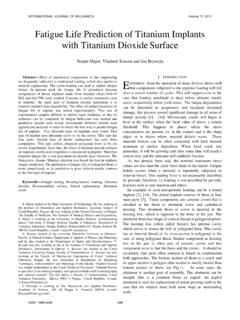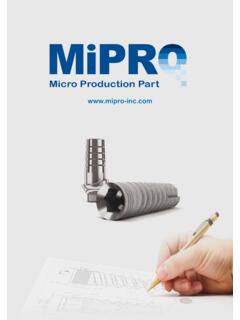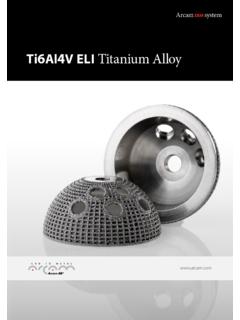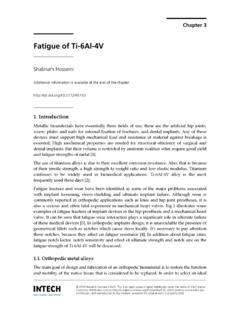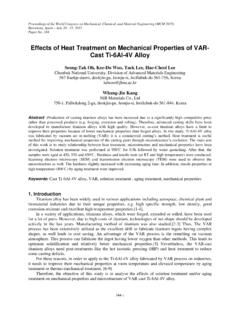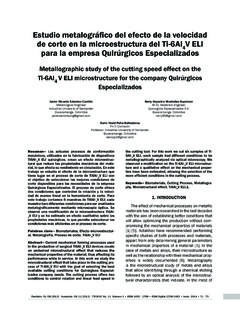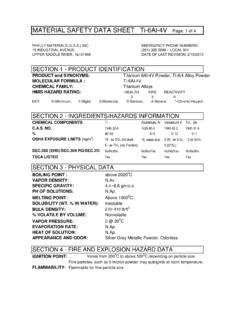Transcription of Standard Specification for Wrought Titanium-6Aluminum ...
1 Designation: F 136 02a Standard Specification for Wrought titanium -6 Aluminum-4 Vanadium ELI (Extra Low Interstitial) Alloy for Surgical Implant Applications (UNS. R56401)1. This Standard is issued under the fixed designation F 136; the number immediately following the designation indicates the year of original adoption or, in the case of revision, the year of last revision. A number in parentheses indicates the year of last reapproval. A. superscript epsilon (e) indicates an editorial change since the last revision or reapproval. 1. Scope * Aerospace Material Specifications:8. This specification covers the chemical, mechanical, and AMS 2249 Chemical Check Analysis Limits, titanium and metallurgical requirements for Wrought annealed titanium - titanium alloys 6aluminum-4vanadium ELI (extra low interstitial) alloy AMS 4930 titanium Alloy Bars, Forgings, and Rings (R56401) to be used in the manufacture of surgical implants.
2 6AL-4V Extra Low Interstitial Annealed The values stated in inch-pound units are to be regarded Society of Automotive Engineers Standard : as the Standard . The SI equivalents in parentheses are provided SAE J1086 Practice for Numbering Metals and alloys for information only. (UNS)9. 2. Referenced Documents 3. Terminology ASTM Standards: Definitions of Terms Specific to This Standard : E 8 Test Methods of Tension Testing of Metallic Materials2 lot, n the total number of mill products produced E 120 Test Methods for Chemical Analysis of titanium and from one heat under the same conditions at essentially the same titanium Alloys3 time. E 290 Test Method for Bend Testing of Materials for 4. Product Classification Ductility3. E 527 Practice for Numbering Metals and alloys (UNS)4 Strip Any product under in.
3 ( mm) in E 1409 Test Method for Determination of Oxygen in Tita- thickness and under 24 in. (610 mm) wide. nium and titanium alloys by the Inert Gas Fusion Tech- Sheet Any product under in. ( mm) in nique5 thickness and 24 in. (610 mm) or more in width. E 1447 Test Method for Determination of Hydrogen in Plate Any product in. ( mm) thick and titanium and titanium alloys by the Inert Gas Fusion over and 10 in. (254 mm) wide and over, with widths greater Thermal Conductivity Method3 than five times thickness. Plate up to in. ( mm), F 981 Practice for Assessment of Compatibility of Bioma- thick inclusive is covered by this specification. terials for Surgical Implants with Respect to Effect of Bar Round bars and flats from in. ( mm) to Materials on Muscle and Bone6 in.
4 ( mm) in diameter or thickness (other sizes and ASQ Standard : shapes by special order). ASQ C1 Specifications of General Requirements for a Forging Bar Bar as described in , used for produc- Quality Control Program7 tion of forgings, may be furnished in the hot rolled condition. Wire Rounds less than in. ( mm) in diam- eter. 1. This specification is under the jurisdiction of ASTM Committee F04 on 5. Ordering Information Medical and Surgical Materials and Devices and is the direct responsibility of Subcommittee on Metallurgical Materials. Include with inquiries and orders for material under this Current edition approved Nov. 10, 2002. Published December 2002. Originally specification the following information: published in 1984. Last previous edition approved in 2002 as F 136 02.
5 Quantity, 2. Annual Book of ASTM Standards, Vol ASTM designation and date of issue, 3. Annual Book of ASTM Standards, Vol 4. Annual Book of ASTM Standards, Vol 5. Annual Book of ASTM Standards, Vol 6 8. Annual Book of ASTM Standards, Vol Available from Society of Automotive Engineers (SAE), 400 Commonwealth 7. Available from American Society for Quality, 600 N. Plankinton Ave., Dr., Warrendale, PA 15096-0001. 9. Milwaukee, WI 53203. New designation established in accordance with E 527 and SAE J1086. *A Summary of Changes section appears at the end of this Standard . Copyright ASTM International, 100 Barr Harbor Drive, PO Box C700, West Conshohocken, PA 19428-2959, United States. 1. F 136 02a Form (sheet, strip, plate, bar, or wire), TABLE 2 Product Analysis ToleranceA.
6 Condition (See ), Tolerance Under the Minimum or Mechanical properties (if applicable, for special con- Element Over the Maximum Limit (Composition %)B. ditions), Nitrogen Finish (See ), Carbon Applicable dimensions including size, thickness, Hydrogen width, or drawing number, Iron Oxygen Special tests, if any, and Aluminum Other requirements. Vanadium A. See AMS 2249. 6. Materials and Manufacture B. Under minimum limit not applicable for elements where only a minimum percentage is indicated. The various titanium mill products covered in this specification normally are formed with the conventional forg- ing and rolling equipment found in primary ferrous and Acceptance or rejection of a heat or manufacturing lot nonferrous plants. The alloy is usually multiple melted in arc of material may be made by the purchaser on the basis of this furnaces (including furnaces such as plasma arc and electron product analysis.)
7 Beam) of a type conventionally used for reactive metals. For referee purposes, use Test Methods E 120, E 1409, Finish The mill product may be furnished to the and E 1447 or other analytical methods agreed upon between implant manufacturer as mechanically descaled or pickled, the purchaser and the supplier. sandblasted, chemically milled, ground, machined, peeled, Ensure that the samples for chemical analysis are polished, combinations of these operations, or as specified by representative of the material being tested. The utmost care the purchaser. must be used in sampling titanium for chemical analysis Condition Material shall be furnished in the annealed because of its affinity for elements such as oxygen, nitrogen, or cold-worked condition. and hydrogen.
8 In cutting samples for analysis, therefore, the operation should be carried out insofar as possible in a 7. Chemical Requirements dust-free atmosphere. Cutting tools should be clean and sharp. Samples for analysis should be stored in suitable containers. The heat analysis shall conform to the chemical com- position of Table 1. Ingot analysis may be used for reporting all 8. Mechanical Requirements chemical requirements, except hydrogen. Samples for hydro- The material supplied under this specification shall gen shall be taken from the finished mill product. Supplier shall conform to the mechanical property requirements in Table 3. not ship material with chemistry outside the requirements Specimens for tension tests shall be machined and tested specified in Table 1.
9 In accordance with Test Methods E 8. Tensile properties shall Requirements for the major and minor elemental be determined using a strain rate of to constituents are listed in Table 1. Also listed are important (mm/mm/min) through yield and then the crosshead speed may residual elements. Analysis for elements not listed in Table 1 is be increased so as to produce fracture in approximately one not required to verify compliance with this specification. additional minute. Product Analysis Product analysis tolerances do not For sheet and strip, the bend test specimen shall with- broaden the specified heat analysis requirements but cover stand being bent cold through an angle of 105 without fracture variations between laboratories in the measurement of chemi- in the outside surface of the bent portion.
10 The bend shall be cal content. The supplier shall not ship material that is outside made around a mandrel which has a diameter equal to that the limits specified in Table 1. The product analysis tolerances shown in Table 3. shall conform to the product tolerances in Table 2. Number of Tests: The product analysis is either for the purpose of Bar, Forging Bar, Shapes, and Wire Perform at least verifying the composition of a heat or manufacturing lot or to one tension test from each lot. Should any of these test determine variations in the composition within the heat. specimens not meet the specified requirements, test two addi- tional test pieces representative of the same lot, in the same TABLE 1 Chemical Requirements manner, for each failed test specimen.
